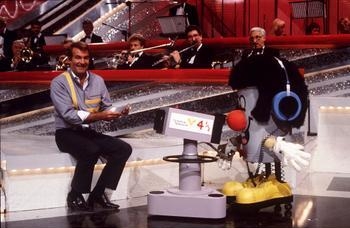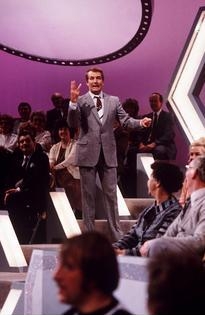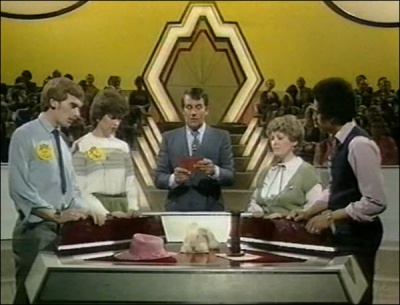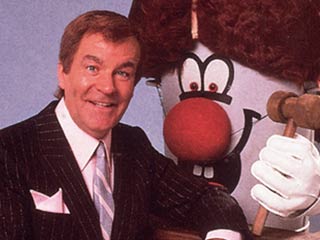3-2-1

Contents |
Host
Co-hosts
Comedy regulars: Mike Newman, Chris Emmett, Duggie Brown, Felix Bowness, Debbie Arnold, Bernie Clifton, George Roper, David Ismay
Hostesses: Mireille Allonville, Jenny Layland, Patsy Ann Scott, Annie St. John, Karen Palmer, Gail Playfair, Tula, Alison Temple-Savage, Libby Roberts, Fiona Curzon, Karan David, Caroline Munro, Lynda Lee Lewis
Announcers: Anthony Schaeffer (1984-5), John Benson (1986-8)
Broadcast
Yorkshire Television for ITV, 29 July 1978 to 24 December 1988 (146 episodes in 10 series + 8 specials)
Synopsis
Three for the price of one
Once entertaining (but in retrospect, truly cringeworthy) prime-time show, which was Yorkshire TV's greatest contribution to ITV game shows before Countdown hit the airwaves. Divided into three key parts - first, the rather jolly quiz where each of the three couples were given two rounds of 10 questions, their money being equal to 10 x first round score x second round score. Contestants were invariably middle-aged couples, and there was a curious affinity for contestants from the North-East and Midlands.
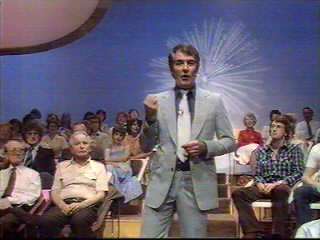 Ted in the middle of his intricate "3-2-1" trademark. A glamorous audience looks on.
Ted in the middle of his intricate "3-2-1" trademark. A glamorous audience looks on.In the very early series (such as the picture below), the quiz was actually in 3 rounds, with £1 paid for the first round questions. Anyway, the maximum was always £1000, which was a lot of money in those days. Also in those years, the winning couple actually sat out the rest of the show and came back to earn more money next week as reigning champions.
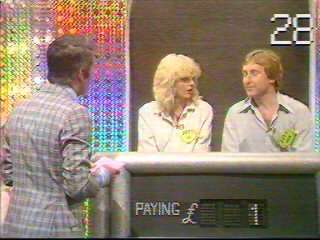 Contestants play the "1000 to 1" quiz
Contestants play the "1000 to 1" quizThe quiz rules changed many times over the years. Originally the couples had to name up to ten things that belonged to a particular category, alternating answers and Ted letting the female have the example as their first answer. Partners could help but in mime only. Something the judges felt didn't fit or a repetition ended the round prematurely, which would cue in a quick joke from the resident comedians. Later the quiz changed so that whilst they were always given the example and they had to answer alternately, there were ten proper questions connected by a theme (complete the phrase or saying, name these celebrities whose surnames all begin with an F, that sort of thing). The round still ended there and then if a wrong answer was given, but they could at least pass and move on (but couldn't come back to it later).
The third and final incarnation of the quiz for its very final series was a straight buzzer quiz - everyone was spotted £10 to begin and each correct answer meant another £10 was added. There were ten questions in round one. In round two (after a quick performance from an upcoming star, one of which was a pre-fame mulleted Shane Richie), there were fifteen questions worth whatever you earnt in round one. This was a bit rubbish really, as it didn't lend itself to the shock results that sometimes happened when the leaders from round one mess-up early from previous series.
The second round also changed over the years. In the early series, a physical game was played that fitted in with the show's theme. This was the version that made the most sense, but the low budgets at the time made the games extremely naff. As more money was available in later series, a computer game (a simple version of Breakout) was used.
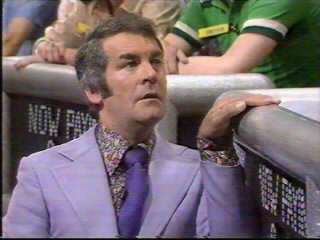 Ted Rogers falls at the knees of one of the hostesses.
Ted Rogers falls at the knees of one of the hostesses.The most modern series used a second round that was essentially just 60% of round three, so let's explain round 3.
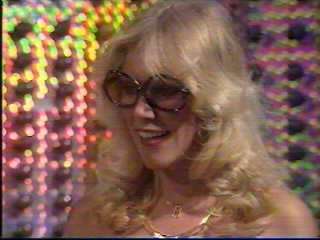 Hostess Mireille Allonville.
Hostess Mireille Allonville.The two remaining couples were brought various cryptic clues by cabaret acts, including magicians and comedy routines. Also in every show was the obligatory dance routine by the in-house "Brian Rogers Connection", which we presume was not a literal title. Previous dance/hostess troupes include "Lipstick" and "The Gentle Secs".
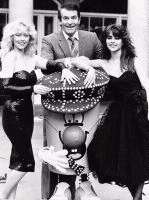 Ted and dancers with Dusty Bin in his Pearly King garb.
Ted and dancers with Dusty Bin in his Pearly King garb.After three clues, a tie-breaker question was read out (see "Key Moments") and the winning couple went on to receive two more objects to which famously impenetrable cryptic clues were attached.
Bin there, done that
They had to try to solve the clues in order to keep the star prize (invariably a car) but eliminate the booby prize, Dusty Bin, a 1980s technological marvel on roller skates powered by four Duracell AA - pick him and all you went home with was a dust bin (a brand new one, mind).
Host with the most
Why did the show work? It's somewhat of a mystery. No-one understood the cryptic clues, the jokes were extremely thin (especially so in the earliest series), but the prizes were pretty good for their day. But for our money, it's Ted Rogers that really carried the show off. The show may look naff by today's standards, but Rogers was a very affable host, always with a nice word to say about people and even the occasional good ad lib to boot.
Key moments
The famous episode (pictured below) that's so good it deserves a full script:
Rogers: "This is a composer. German by birth, English by adoption. Best known for an oratorio published in 1741. It was called Messiah. You're bound to know his handle."
Female contestant: (presses buzzer) "Oh God, I used to have it at school... Handel's Water Music..."
Rogers: "So who's the composer?"
Female contestant: "Chopin?"
(audience shrieks in disbelief)
Rogers: (shrugs shoulders and turns to other team) "So I can offer it to you."
Male contestant: "Beethoven?"
Catchphrases
Ted's warning the contestants of the consequences of being left with Dusty Bin: "Remember all you win is a brand new dustbin!" he'd explain, just in case (as many viewers thought) that they might win a state of the art robot worth more than any other prize ever offered on the show.
Who could forget "Whiplash" Rogers' 3-2-1 hand movement?
Inventor
Based on the Spanish show Un, Dos, Tres, devised by Ibanez Serrador. It was called 3-2-1 because it was three things in one - a quiz, a game and a variety show.
Theme music
Composed by Johnny Pearson
Trivia
Note the little Yorkshire Television "Y" symbol in the show's logo.
The technical term for the clue objects that were brought to the table was a McGuffin, so-called because that's the name Alfred Hitchcock used to describe key objects that provided red herrings in his mystery films.
Dusty Bin cost £10,500 to build (quite a chunk of change in those days) and never broke down. It was built by special effects company Rowley Electronics, who later went on to devise the effects used on Fun House.
Popular DJ Janice Long appeared as a contestant with her then-husband Trevor on the very first show in 1978.
By 1987, there was a write-in competition in the TV Times. Five winners got a ceramic Dusty Bin. The winner got a 21-inch colour television.
3-2-1 keeps turning up in critics' lists of the "worst ever" TV shows. In July 2006 it was included among John Naughton's 50 worst list in Radio Times and then a few months later it featured in a list of the "Terrible 20" worst-ever shows in Jeff Evans' book The Penguin TV Companion, alongside recent flops Shafted and Celebrity Wrestling, long-forgotten one-shot Top of the World and sixteen programmes from outside the game show arena.
Web links
See also
Weaver's Week review of the first three series, written in 2014.
Pictures
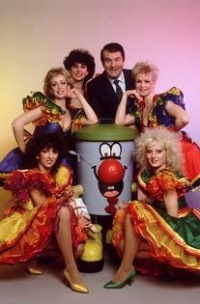 A dustbin (see below) surrounded by Ted Rogers and the Connection.
A dustbin (see below) surrounded by Ted Rogers and the Connection.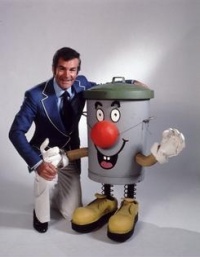 Ted Rogers with booby prize Dusty Bin
Ted Rogers with booby prize Dusty Bin
